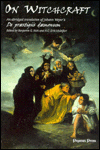Johann Weyer (1515-1588)


A Divided Image
In standard psychiatric histories, Weyer has been represented as "the father of modern psychiatry," a heroic figure some 400 years ahead of his time: driven by a compassionate humanism and a desire for the truth, he systematically demolished an ideology that preyed on deluded women. He did so with deference to theological authority, however, taking care to support himself with a Biblical literature review and using demonological terms as a kind of shorthand for illness, suffering and mental disorder. His devastating arguments evoked a heated response and inspired future generations of sceptics, who eventually succeeded in crushing the witch hunts. Carl Binz promoted this view in the late nineteenth century, as part of the construction of psychiatry as a discipline, and Gregory Zilboorg is the classic exponent, but it is still widespread. It is true that Weyer's work was known to Charcot and Freud, probably influencing the latter, but this view entails ignoring much of what Weyer said about demons and turning his remarks about a few crazed women into a general statement about all the cases.
To social and intellectual historians, however, Weyer
is a very different man, an anti-Catholic polemicist who was nevertheless
fascinated by demonology; Weyer actually assigned more power to the Devil
than his witch-burning adversaries ever had. The extent to which his work
participated in traditional demonological discourse, and was received by
readers as such, is clearly indicted on the title pages of the German editions
of his book. [see below] His style of argument, while occasionally
incisive, was characteristically illogical, contradiction-laden, and myopic.
Weyer's case was so weak that the opposition was astounded when he dared
to republish it; their response demolished his contentions, and
the net result of his efforts was to exacerbate an already
tense situation. Towards the end of Weyer's life, Duke William reinstituted
trial by ordeal and torture in witchcraft cases. Stuart Clark, in
the course of his massive study of demonology, Thinking with Demons,
offers excellent and balanced examinations of both Weyer and his opponent,
Jean
Bodin. See also Christopher Baxter's essays on both Weyer and
Bodin in Anglo's The Damned Art.


BIBLIOGRAPHY
 Johann
Weyer, Witches, Devils, and Doctors in the Renaissance: Johann Weyer,
De praestigiis daemonum, intro. and notes by George Mora; trans. John
Shea. Binghamton, New York: Medieval & Renaissance Texts & Studies,
1991 [The abridged version, edited by H.C.E.Midelfort, is shown
here.]
Johann
Weyer, Witches, Devils, and Doctors in the Renaissance: Johann Weyer,
De praestigiis daemonum, intro. and notes by George Mora; trans. John
Shea. Binghamton, New York: Medieval & Renaissance Texts & Studies,
1991 [The abridged version, edited by H.C.E.Midelfort, is shown
here.]
Sydney Anglo, ed. The Damned Art: Essays in the Literature of Witchcraft. London: Routledge and Kegan Paul, 1977.
Sydney Anglo, "Melancholia and Witchcraft: The Debate between Wier, Bodin, and Scot", Articles on Witchcraft, Magic and Demonology: The Literature of Witchcraft, ed. Brian P. Levack. New York and London: Garland Publishing, Inc., 1992, pp.137-50. Orig. publ.in Gerlo, ed., Folie et Deraison a la Renaissance (Brussels: Editions de l'Universite de Bruxelles, 1976) pp.209-28
Charles Béné, "Jean Wier et les procès de sorcellerie ou l´Erasmisme au service de la tolérance", in P.Tuynman, G.C. Kuiper, and E. Kessler, eds., Acta Conventus Neo-latini Amstelodamensis (Munich, 1979) 58-73
Urs-Benno Birchler-Argyros, "Zauberei und Gerichtsmedizin. 16. bis 18. Jahrhundert", Gesnerus 43 (1986) 85-108
Sona Rosa Burstein, "Demonology and Medicine in the Sixteenth and Seventeenth Century", Folklore 67 (1956) 15-33
Stuart Clark, "The Scientific Status of Demonology", in Brian Vickers (ed.), Occult and Scientific Mentalities in the Renaissance (Cambridge, 1984) 351-374
Stuart Clark, "Protestant Demonology: Sin, Superstition, and Society (c. 1520 - c. 1630)", in Bengt Ankarloo and Gustav Henningsen (eds.), Early Modern European Witchcraft: Centres and Peripheries (Oxford, 1990) 45-81
Stuart Clark, Thinking with Demons: The Idea of Witchcraft in Early Modern Europe, Oxford: Oxford University Press, 1996
Leland L. Estes, "The Medical Origins of the European Witch Craze. A Hypothesis", Journal of Social History 17 (1983) 271-284
H.C.Erik Midelfort, "Johann Weyer and the Transformation of the Insanity Defense", The German People and the Reformation, ed. R. Po-Chia Hsia, Ithaca: Cornell University Press, 1988, pp. 234-61
H. C. Erik Midelfort, A History of Madness in Sixteenth-Century Germany, Stanford: Stanford University Press. 1999
Sam Migliore, "The Doctor, the Lawyer, and the Melancholy Witch", Anthropologica 25 (1983) 163-192
Patrick Vandermeersch, "The victory of psychiatry over demonology: the origin of the nineteenth-century myth", History of Psychiatry 2 (1991): 351-363
E.T.Withington, "Dr. John Weyer and the Witch Mania", Articles on Witchcraft, Magic and Demonology: The Literature of Witchcraft, ed. Brian P. Levack. New York: Garland, 1992, pp.33-68. Orig. publ. in Charles Singer, ed., Studies in the History and Method of Science (Oxford: Clarendon Press, 1917-20, Vol. I) pp.189-224
Gregory Zilboorg, The Medical Man and the Witch during the Renaissance (Baltimore, 1969)